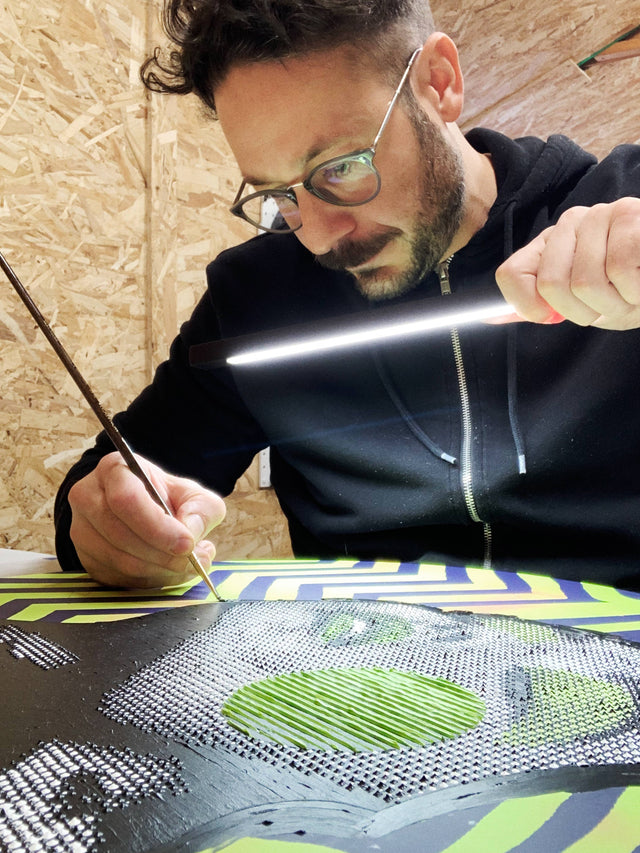Crafting Dimensions: A Deep Dive into process
Today, I invite you to delve into the intricacies of my creative process, with a particular focus on the Electric Dreams series. I'll guide you through each step, offering insights into the deliberate choices and techniques that shape each piece.
Digital by Design:
My process begins with a meticulously chosen image generated by AI. This phase of the journey is more directional than artistic, in my opinion. Although some of the outputs generated by AI are considered art, the human involved is nothing more than an art director, certainly not the artist. While some artists choose to hit the 'print' button at this point and call the work 'theirs,' I use the output as a bare canvas to work from. The decision to utilize this technology in this way is purposeful and fundamental to the hypothetical and philosophical concepts of Electric Dreams, which I'll delve into in another post. It's essential to stress that AI is employed solely to create a photorealistic person, supporting the idea of asking AI to create something it deems as ‘real.’ I then take that and transform it into a physical piece of art with a digital aesthetic, something we would deem as 'real.
Analog Experiments:
Now, let's step into the realm of tactile artistry. This phase involves a series of analog techniques that add layers of depth and character to the artwork. It's a somewhat humorous and enjoyable stage, as all these steps could be executed digitally and at a faster pace. However, there's an intangible quality that doesn't translate when created on a computer. It involves trusting in random, tactile events and embracing unexpected results:
-
Lo-Fi Printing: Embracing the imperfections of a run-of-the-mill inkjet printer adds virtues to the process. Quirks and irregularities become integral to the visual narrative.
-
Tearing and Distressing: Intentionally introducing wear and tear echoes the transient nature of perception, introducing impermanence into the artistic dialogue. This involves tearing pieces of old paper and scratching portions of print, resulting in a real-to-touch aesthetic.
-
Hand-Warping via Scanners: A favourite phase involving an old, battered scanner, trusted to produce unexpected outcomes. Patterns, textures, or found assets are warped by pulling them across the scanner during operation, creating a twisted result.
-
Collaging: Piecing together elements that are torn, distressed, and warped further results in a rich visual tapestry. It speaks to the interconnectedness of ideas and forms, making these analog techniques deliberate choices that infuse the artwork with a tangible, human touch.
Physical Manifestation:
Once the digital and analog realms harmonise to my satisfaction, it's time to bring the art into the physical world. This is the phase often seen on Instagram, where all the preparation comes together:
-
Prepping the Substrate: Birch Plywood is my canvas, requiring meticulous preparation with two layers of sealant to prevent yellowing over time. After that, an extensive process of layering, sanding, and buffing creates a smooth Venetian plaster-style effect, a step that cannot be compromised.
-
Screen Printing: This foundational step brings layers of colour and texture, laying the groundwork for the piece. Screen printing on thick or uneven surfaces presents challenges that require time and expertise to overcome.
-
Stencils and Spray Painting: Precision meets spontaneity as stencils guide spray paint, adding nuanced details and bursts of energy. This time-consuming process involves developing a clean edge with no bleed-under.
-
Traditional Painting: Brushstrokes play a crucial role in imbuing the piece with emotion and a distinct human touch. Every artist leaves a bit of themselves in their art, and it's particularly evident in brushstrokes.
-
Hand-Applied Halftones with Thickened Acrylic: This final stage, perfected over two years, adds a meticulous touch that elevates the piece into almost 3D territory. Each carefully placed halftone contributes to intricate depth and texture. While the halftone effect is synonymous with a digital connection, executing it by hand blends the concepts of human and machine, reinforcing the Electric Dreams concept.
The Result:
The culmination of these choices, processes, and the intimate conversation between the artist and the artwork is an almost 3D piece. It transcends the boundaries between digital and physical, inviting exploration into the layers, textures, and nuances that make each piece a unique dimension. Art is not just about what you see; it's about the experience, and in each stroke, tear, and pixel, I invite you to join me on this exploration.



Thank you for being part of my artistic journey and I hope to give you more updates on this type of content soon!
If you enjoy this type of content, please sign up for my newsletter using the form below. You'll receive posts that share my latest news, processes, and some helpful how-to guides.

